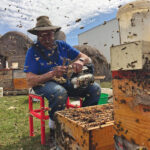Honeybees in human-made hives may have suffered the cold unnecessarily for over a century because commercial hive designs are based on erroneous science. For 119 years, a belief that the way honeybees cluster together provides a kind of evolutionary insulation has been fundamental for beekeeping practice, hive design and honeybee study. In the modern day,













